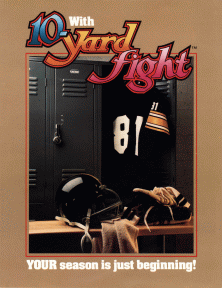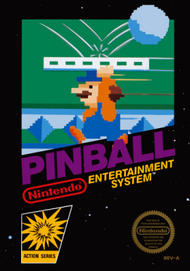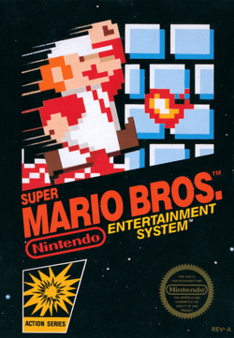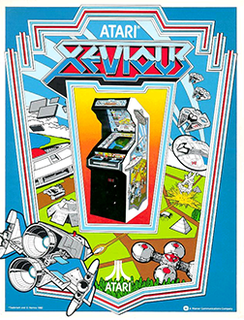 W
WThe Nintendo VS. System is an arcade system developed and produced by Nintendo from 1984 to 1990. It is based on most of the same hardware as the Family Computer (Famicom), later released as the Nintendo Entertainment System (NES). Most of its games are conversions from the Famicom/NES, some heavily altered for the arcade format, while some titles debuted on the VS. System before releasing for the Famicom/NES. The system focuses heavily on two-player cooperative play. It was released in three different configurations: upright VS. UniSystem cabinets, upright VS. DualSystem cabinets, and sit-down VS. DualSystem cabinets. Games are on pluggable circuit boards, allowing for each side to have a different game.
 W
W10-Yard Fight is an American football sports video game that was developed and published in Japan by Irem for arcades in 1983. It was published overseas by Taito in the Americas, by Electrocoin in Europe, and by ADP Automaten GmbH in West Germany.
 W
WBalloon Fight is an action video game developed by Nintendo. The original arcade version was released for the Nintendo VS. System internationally as Vs. Balloon Fight, while its Nintendo Entertainment System counterpart was released in Japan in 1985 and internationally in 1986.
 W
WBaseball is a video game from Nintendo. It was released December 7, 1983, soon after the July 15 launch of the Famicom in Japan. In 1984, it was ported to the VS. System arcade as VS. Baseball with additional graphics and speech, becoming a number one hit in Japan and North America that year. It was localized as a Nintendo Entertainment System launch game in North America in 1985, and in Europe in 1986. IGN said the universal appeal of the American sport made Baseball a key to the NES's successful test market introduction, and an important piece of Nintendo history. The game was also competing with Sega's arcade hit Champion Baseball, released earlier in 1983.
 W
WBattle City is a multi-directional shooter video game for the Family Computer produced and published in 1985 by Namco. It is a successor to Namco's 1980 Tank Battalion, and would be succeeded itself by the 1991 Tank Force.
 W
WCastlevania, known in Japan as Akumajō Dracula, is a platform game developed and published by Konami for the Family Computer Disk System video game console in Japan in September 1986. It was ported to cartridge format and released in North America for the Nintendo Entertainment System (NES) in May 1987 and in Europe in 1988. It was also re-issued for the Family Computer in cartridge format in 1993. It is the first game in Konami's Castlevania video game series.
 W
WClu Clu Land is an arcade and Nintendo Entertainment System game released in 1984 in Japan, later released in North America in 1985 as a Nintendo Entertainment System launch title, and in Europe in 1987. Nintendo has rereleased it many times via emulation.
 W
WDr. Mario is a 1990 action puzzle video game produced by Gunpei Yokoi and designed by Takahiro Harada. Nintendo developed and published the game for the Nintendo Entertainment System and Game Boy consoles. The game's soundtrack was composed by Hirokazu Tanaka.
 W
WDuck Hunt is a 1984 light gun shooter video game developed and published by Nintendo for the Nintendo Entertainment System (NES) video game console and the Nintendo Vs. System arcade hardware. The game was first released in April 1984, in Japan for the Family Computer (Famicom) console and in North America as an arcade game. It was then released as a launch game for the NES in North America in October 1985, with it also releasing in Europe two years later.
 W
WExcitebike is a motocross racing video game developed and published by Nintendo. In Japan, it was released for the Famicom in 1984 and then ported to arcades as Vs. Excitebike for the Nintendo Vs. System later the same year. In North America, it was initially released for arcades in 1985 and then as a launch title for the Nintendo Entertainment System later the same year. It is the first game in the Excite series.
 W
WFreedom Force is a video game created by Sunsoft and released in 1988 for the Nintendo Entertainment System. In the game, the player takes the role of a sharpshooter in a counter-terrorist organization. Freedom Force was also one of the few NES games to require the NES Zapper light gun accessory. The game was released in arcades on the Nintendo Vs. System as Vs. Freedom Force.
 W
WGolf is a golf-based sports simulation video game developed and released by Nintendo in 1984 for the Famicom in Japan. Later the same year, it was ported to the Nintendo VS. System as VS. Golf or Stroke and Match Golf, released in arcades internationally, followed by another arcade version called VS. Ladies Golf. The original was re-released for the NES in North America in 1985, and for the Famicom Disk System in 1986 in Japan.
 W
WThe Goonies is a 1986 platform game based on the film of the same name produced by Konami for various Japanese computer systems. Konami also developed a completely different version for the Family Computer in Japan. First released on cartridge, it was later re-released in Disk System format in 1988. Although the game was never sold in retail in North America, Nintendo published an arcade port in North America for the VS. System under the title Vs. The Goonies and it was also available as a PlayChoice-10 title in the region. A sequel was released titled The Goonies II, which saw a worldwide retail release.
 W
WGradius is a side-scrolling shooter video game developed and published by Konami. The first game in the Gradius series, it was originally released as a coin-operated arcade game in 1985. The player maneuvers a spacecraft known as the Vic Viper that must defend itself from the various alien enemies. The game uses a power-up system called the "power meter", based upon collecting capsules to purchase additional weapons.
 W
WGumshoe is a video game developed and published by Nintendo for the NES and released in 1986 in North America and in 1988 in Europe. Gumshoe is played using the NES Zapper. The game was designed by Yoshio Sakamoto.
 W
WHogan's Alley is a light gun shooter video game by Nintendo, released for the Nintendo Entertainment System in 1984 and then the arcade Nintendo VS. System in 1985. It was one of the first hit video games to use a light gun as an input device, along with Nintendo's Duck Hunt (1984). The game presents players with "cardboard cut-outs" of gangsters and innocent civilians. The player must shoot the gangs and spare the innocent people. It was a major arcade hit in the United States, where it was the highest-grossing arcade system game of 1985, as well as Europe.
 W
WIce Climber is a platform game developed and published by Nintendo for the arcade Nintendo VS. System in 1984 and the Nintendo Entertainment System console in 1985. In Ice Climber, the characters Popo and Nana, collectively known as the Ice Climbers, scale 32 vertically scrolling, ice-covered mountains to recover stolen vegetables from a giant condor. In some European countries, Ice Climber was a pack-in game for the NES console.
 W
WMach Rider is a futuristic vehicular combat video game created by Nintendo. It was first released in Japan in 1985 for the Nintendo Family Computer, and then in North America a year later for the Nintendo Entertainment System, and in 1987 for the PAL region. Later it was released on the Virtual Console for the Wii (2007), Nintendo 3DS (2013) and Wii U (2014).
 W
WMighty Bomb Jack is a 1986 Nintendo Entertainment System (NES) game released by Tecmo, which was later ported to the Amiga, Atari ST and Commodore 64. Mighty Bomb Jack is a sequel to the 1984 game Bomb Jack.
 W
WPinball is a pinball video game developed and released in 1984 by Nintendo for the Famicom. It is based on a Game & Watch unit of the same name, and was later released as an arcade game for the Nintendo VS. System in Japan and North America that year. In 1985, it was a launch game for the Nintendo Entertainment System in North America.
 W
WPro Baseball: Family Stadium, released as Pro Yakyū: Family Stadium in Japan and R.B.I. Baseball in North America, is a 1986 baseball video game originally developed and published by Namco for the Family Computer (Famicom). In North America, it was published by Tengen for arcade and Nintendo Entertainment System platforms as R.B.I. Baseball. It is the first game in the Family Stadium and R.B.I. Baseball franchises. The game was a critical and commercial success in Japan and North America.
 W
WR.B.I. Baseball is a baseball sports video game series. R.B.I. is an initialism for "run batted in". Originally launched in 1987 as a localized version of Namco's Family Stadium series, the R.B.I. Baseball series initially ran through 1995. In 2014, the series was rebooted as a competitor to MLB: The Show, with releases each year since.
 W
WRaid on Bungeling Bay was the first video game designed by Will Wright. It was published by Broderbund for the Commodore 64 in 1984. The Commodore 64 version was published in the UK by Ariolasoft. The game inspired Wright to develop SimCity in 1989.
 W
WSlalom, originally released as VS. Slalom, is a skiing sports video game in which the player races in a series of downhill slalom runs while navigating past flags and obstacles before time expires. It was developed by Rare and first released by Nintendo in 1986 for the Nintendo VS. System in arcades. It was then released for the Nintendo Entertainment System (NES) in North America in March 1987 and in Europe later that year. The game was developed by Tim and Chris Stamper and its music was composed by David Wise.
 W
WSuper Mario Bros. is a platform game developed and published by Nintendo. The successor to the 1983 arcade game Mario Bros. and the first in the Super Mario series, it was released in 1985 for the Famicom in Japan. Following a limited US release for the Nintendo Entertainment System (NES), it was ported to international arcades for the Nintendo Vs. System in early 1986. The NES version received a wide release in North America that year and in PAL regions in 1987.
 W
WSuper Xevious: GAMP no Nazo is a 1986 vertical-scrolling shooter video game developed and published by Namco for the Family Computer in Japan. It is the sequel to Xevious, a popular arcade game from 1983, and the fourth installment in the Xevious franchise overall. The player controls a spaceship named the Solvalou in its mission to destroy a powerful supercomputer named GAMP, which took over Earth during an ice age. GAMP no Nazo features a heavy focus on puzzle-solving, with each of the game's 21 levels posing a puzzle that must be solved to progress.
 W
WTennis is a sports video game developed by Nintendo in 1983, and released for the Family Computer (Famicom) in 1984. The arcade game version Vs. Tennis was also released for the Nintendo VS. System in 1984, becoming a hit at Japanese and American arcades that year; it was the sixth top-performing arcade game of 1984 in the United States. Tennis is one of 17 launch games for the Nintendo Entertainment System (NES) in North America and Europe. The game was re-released for the Game Boy as a launch game in North America.
 W
WTop Gun is a shoot 'em up combat flight simulation game based on the 1986 hit film of the same name. It was developed and published by Konami, and released for the Nintendo Entertainment System (NES). It was released in the United States in November 1987, and was subsequently released in Europe. The game is an adaptation of Vs. Top Gun, a 1987 Nintendo VS. System arcade game also by Konami. As the second game to establish the Top Gun game series, it was then followed by Top Gun: The Second Mission.
 W
WTrojan is a side-scrolling action game produced by Capcom, originally released as a coin-operated arcade game in 1986, and distributed in North America by Romstar and Capcom. Directed by Takashi Nishiyama, the game includes beat 'em up and hack-and-slash elements. It is a spiritual successor to the beat 'em up Kung-Fu Master (1984), which was designed by Nishiyama at Irem before he left for Capcom, where he evolved its gameplay concepts with Trojan. It is also considered a spiritual successor to Capcom's Ghosts 'n Goblins (1985), which has similar side-scrolling action gameplay elements.
 W
WUrban Champion (アーバンチャンピオン) is a two-player fighting game produced by Nintendo and released in 1984 for the Nintendo Entertainment System console and Nintendo VS. System arcade hardware. It was inspired by the 1984 Game & Watch title Boxing. It is Nintendo's first 2D fighting game, eventually followed in 1993 by Joy Mech Fight, released exclusively in Japan for the same platform.
 W
WXevious is a vertically scrolling shooter developed by Namco and released in arcades in 1982. It was published in Japan and Europe by Namco and in North America by Atari, Inc. Controlling the Solvalou starship, the player attacks Xevious forces before they destroy all of mankind. The Solvalou has two weapons at its disposal: a zapper to destroy flying craft, and a blaster to bomb ground installations and enemies. It runs on the Namco Galaga arcade system.